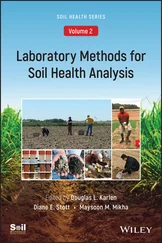Soil Health Analysis, Set
Здесь есть возможность читать онлайн «Soil Health Analysis, Set» — ознакомительный отрывок электронной книги совершенно бесплатно, а после прочтения отрывка купить полную версию. В некоторых случаях можно слушать аудио, скачать через торрент в формате fb2 и присутствует краткое содержание. Жанр: unrecognised, на английском языке. Описание произведения, (предисловие) а так же отзывы посетителей доступны на портале библиотеки ЛибКат.
- Название:Soil Health Analysis, Set
- Автор:
- Жанр:
- Год:неизвестен
- ISBN:нет данных
- Рейтинг книги:3 / 5. Голосов: 1
-
Избранное:Добавить в избранное
- Отзывы:
-
Ваша оценка:
- 60
- 1
- 2
- 3
- 4
- 5
Soil Health Analysis, Set: краткое содержание, описание и аннотация
Предлагаем к чтению аннотацию, описание, краткое содержание или предисловие (зависит от того, что написал сам автор книги «Soil Health Analysis, Set»). Если вы не нашли необходимую информацию о книге — напишите в комментариях, мы постараемся отыскать её.
Soil Health Analysis, Set — читать онлайн ознакомительный отрывок
Ниже представлен текст книги, разбитый по страницам. Система сохранения места последней прочитанной страницы, позволяет с удобством читать онлайн бесплатно книгу «Soil Health Analysis, Set», без необходимости каждый раз заново искать на чём Вы остановились. Поставьте закладку, и сможете в любой момент перейти на страницу, на которой закончили чтение.
Интервал:
Закладка:
Conservation was given another boost under the Kennedy and Johnson administrations in the 1960s when SCS’ role was expanded to address both rural and urban land use. Through an emphasis on rural development, SCS began to work with landowners in areas larger than small watersheds or conservation districts. The late 1960s can also be characterized as a time of broad popular concern regarding the environment, health, and welfare of people throughout the United States and around the world (e.g., Norman Borlaug and the Green Revolution). The first Earth Day in 1970 increased environmental awareness, and ultimately a national framework of environmental policies was created that changed the way the SCS put conservation on the ground. Soon, federal agencies were required to evaluate and report on the environmental impacts of their activities.
Water quality and non‐point source pollution became important areas of concern. Protection of wetlands emerged as critical issue with SCS participation in the Water Bank program and provided incentives to landowners to protect wetland habitat (NRCS, 2018). During the 1970s, SCS also gained greater authority to monitor and assess the nation’s natural resource base through the National Resources Inventory (NRI) – a focal point for future soil quality assessment studies. Finally, in response to these expanded authorities, the Congress changed SCS’s name to the Natural Resources Conservation Service (NRCS) in 1994 (NRCS, 2018).
For brevity, this chapter references only a few significant soil research studies, laws and policies. For example, one federal program that did lead efforts to include soil health in the research portfolio for was the Sustainable Agricultue Research and Education (SARE)] program, but until recent private sector efforts (Chapter 1) steadily increasing farm size and purchased inputs minimized the impact of that program across the broader agricultural community. This chapter has also likely failed to appropriately recognize many of the pillars in soil management research and extension (Karlen et al., 2014a) that contributed substantially to the soil conservation foundation upon which soil health has evolved. Some of those outstanding contributions include studies by Balfour, Bidwell, Hole, Hyams, Jenny, Leopold, Rodale, Whitney, Yaalon, and many others. Without question, all contributed significant knowledge and understanding the soil functions providing the science‐based foundation for current soil health endeavors.
From 1970 to 2000 – Soil Quality Emerges
Concept Development
As noted previously, soil physical and chemical aspects of soil management dominated post‐World War II activities for most soil and crop scientists. We suggest this reflected our limited understanding of soil biological properties and processes as well as the lack of instrumentation and analytical tools that are now available. None‐the‐less several well recognized soil microbiologists such as Allison (1968, 1973), James P. Martin (1939, 1940, 1971), Eldor Paul (Mathur and Paul, 1967; Paul and Voroney, 1980; Paul, 2014), and Martin Alexander (Alexander, 1961, 1980; Acea et al., 1988) contributed insights that expanded the foundation upon which soil health has evolved. There was also an increasing awareness that decreased use of crop rotations, increased size and weight of farm tractors and implements, as well as increased use of conservation tillage practices, were having measurable soil tilth effects in the northern Corn Belt (Voorhees, 1979). Soil compaction, caused by those factors, was recognized as being important for several reasons, including its effect on annual freezing and thawing processes (Voorhees et al., 1978; Voorhees, 1983; Voorhees and Lindstrom, 1984). Coupled with increasing concern regarding soil degradation, Pierce et al. (1983, 1984) conducted several erosion – productivity studies and Dormaar et al. (1988) intentionally eroded a Dark Brown Chernozemic soil (Mollisol) to demonstrate that applying commercial fertilizer or manure could restore soil productivity. However, during a subsequent drought, only the sites that received manure maintained yields and furthermore, after five years those treatments showed increased SOM content and improved water‐stable aggregation.
Warkentin and Fletcher (1977) introduced the concept of soil quality, which in many ways became the foundation for current soil health activities. The transition to soil quality emphasized the multiple ecosystem services (i.e., food and fiber production, recreation, and recycling or assimilation of wastes or other by‐products) that soils must provide (Carter et al., 1997). A focus on soil quality required recognition that: (1) soil resources are constantly being evaluated for many different uses; (2) multiple stakeholder groups are concerned about soil resources; (3) society’s priorities and demands on soil resources are changing; and (4) soil resource and land use decisions are made in a human or institutional context (Warkentin and Fletcher, 1977). They also stated that because of inherent differences among soils, there is no single measurement that will always be useful for evaluating soil quality (Karlen et al., 2003a).
Another 1980s soil and crop management challenge influencing SOM, erosion, and crop productivity was the suggested harvest of crop residues for off‐site bioenergy generation (Paul et al. 1980; Blevins et al. 1983; Elliot and Papendick, 1986). This was spurred by the 1970s energy crisis, and although a portion of the crop residue remaining after grain harvest had traditionally been harvested and used for animal feed or bedding, off‐site transport of the crop residues was the critical issue being questioned (Karlen et al., 1984). On‐farm use resulted in recycling of nutrients and organic matter via manure disposal, but off‐site transport would likely prevent closing field‐specific carbon cycles.
Soil Quality Assessment
Following the 1970s oil crisis, new questions regarding the potential use of crop residues for bioenergy began to emerge as a conservation issue directly linking urban and rural communities. Field research designed to quantify the impact of crop residue harvest on SOM and subsequent productivity resulted in the evolution of a soil health assessment framework. An experiment in southwestern Wisconsin that quantified soil and corn yield response to removing, doubling, or retaining crop residue for 10 years (Karlen et al., 1994a) with moldboard‐, chisel‐, or no‐tillage practices (Karlen et al., 1994b). To more effectively interpret the combined biological, chemical, and physical responses to those treatments, a soil quality/health assessment framework that later becomes known as the Soil Management Assessment Framework (SMAF) (Andrews et al., 2004) was developed. Simultaneously, other assessment tools including an expanded Soil Conditioning Index (SCI), AgroEcosystem Performance Assessment Tool (AEPAT), and Cornell Soil Health Test (now known as the Comprehensive Assessment of Soil Health or CASH) also began to evolve.
The soil tilth review (Karlen et al., 1990) prompted advancement of soil quality/soil health concepts through a Rodale Foundation workshop (Rodale Institute, 1991) that was described by Haberern (1992) as coming “full circle” in reference to J. I. Rodale’s 1942 vision of a “soil‐care revolution.” Rodale had stated that greater awareness to soil health was needed to create “a healthy society, a country of prosperous farms, and healthy, vigorous people.” An important outcome of the Rodale workshop was consensus regarding the need for soil assessments that went beyond productivity and included environmental quality, human and animal health. There was also a realization that assessing and monitoring soil health was complicated by the need to consider multiple soil functions and integrate physical, chemical and biological attributes (Papendick and Parr, 1992; Parr et al., 1992; Warkentin, 1995). Discussions regarding subtle differences between inherent and dynamic soil quality indicators were another important outcome of the Rodale workshop.
Читать дальшеИнтервал:
Закладка:
Похожие книги на «Soil Health Analysis, Set»
Представляем Вашему вниманию похожие книги на «Soil Health Analysis, Set» списком для выбора. Мы отобрали схожую по названию и смыслу литературу в надежде предоставить читателям больше вариантов отыскать новые, интересные, ещё непрочитанные произведения.
Обсуждение, отзывы о книге «Soil Health Analysis, Set» и просто собственные мнения читателей. Оставьте ваши комментарии, напишите, что Вы думаете о произведении, его смысле или главных героях. Укажите что конкретно понравилось, а что нет, и почему Вы так считаете.












